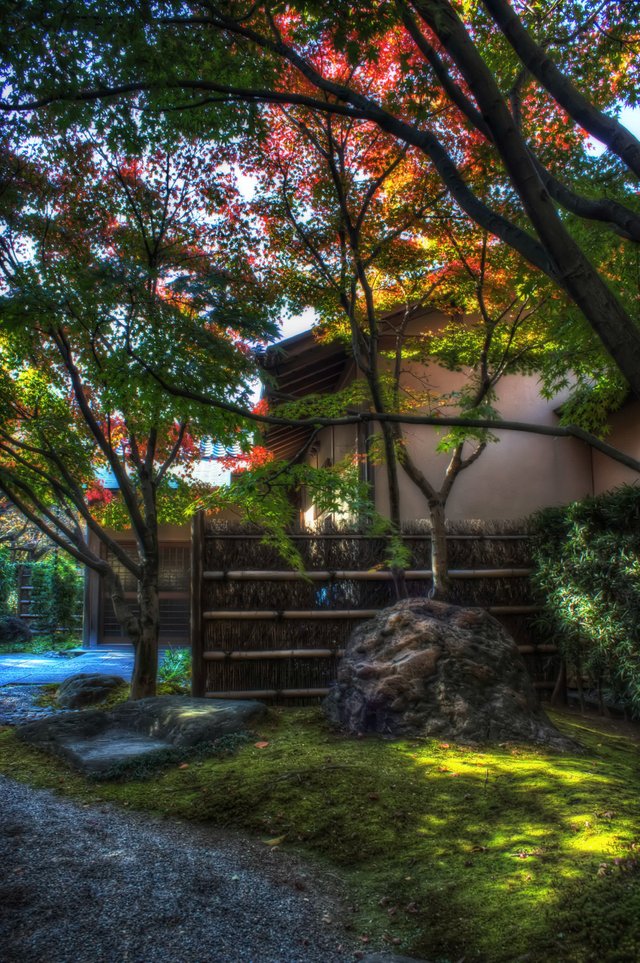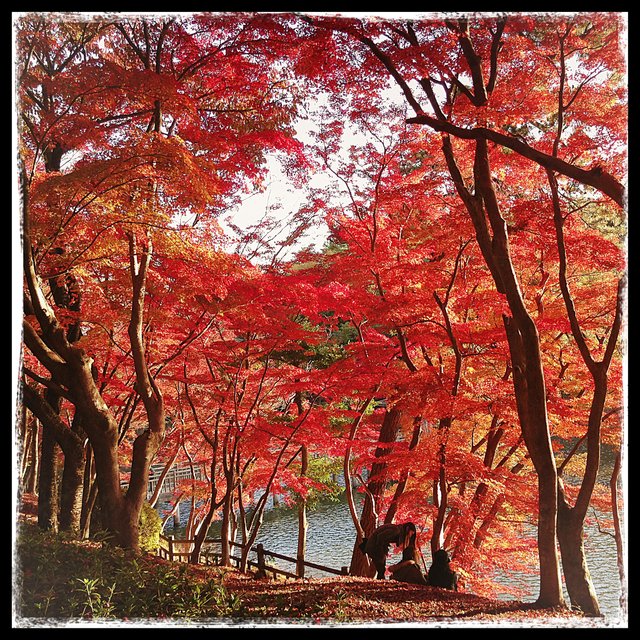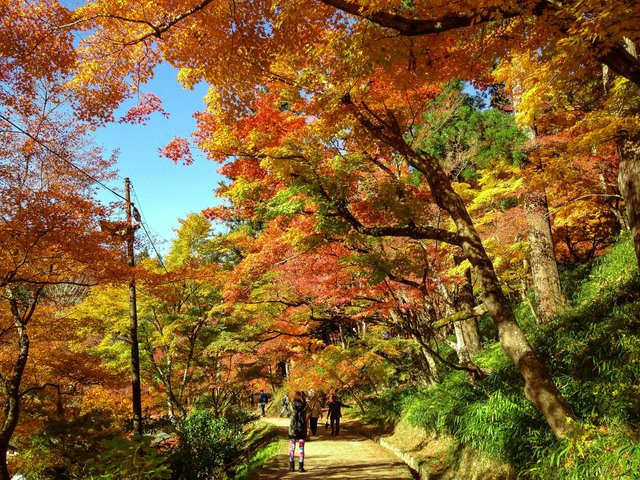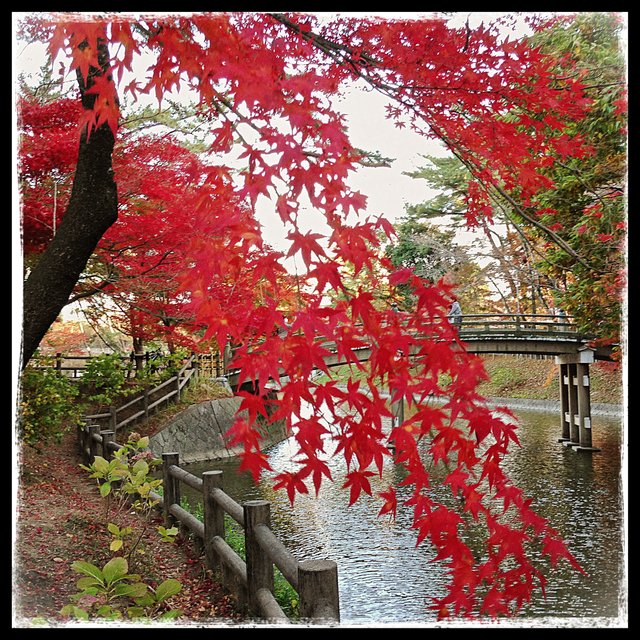Can you guess what this is?

When folks think Japan, probably one of the images that comes to mind is some kind of zen image of nothing but stark black and whites. A monochrome people going about their monochrome lives in a boring monochrome way. Although that can be true in places, in others they are much more colorful than we are in America. Example: Colorful roof tiles.
❦
Thank you for visiting and reading :)
Recent Beautiful Japan Photos

Hidden Autumn Garden |

I Could Sit Under Here Forever With You |

Catching Mother Nature |

Autumn at the Hidden Bridge |
❦
 | David LaSpina is an American photographer lost in Japan, trying to capture the beauty of this country one photo at a time. More? |
All photos copyright © David LaSpina 2017-2018, but free to use for personal use due to the extremely generous terms of the Creative Commons BY-NC-SA license. Spiffy! More details here.
Thank you for using CryptoSicko!
Well done and thank you for joining and supporting my subscription based upvoting bot that provides you with daily upvotes in exchange for your spare STEEM POWER.
Delegation links for CryptoSicko
100SP 250SP500SP
Downvoting a post can decrease pending rewards and make it less visible. Common reasons:
Submit
Hi, @dbooster!
You just got a 1.47% upvote from SteemPlus!
To get higher upvotes, earn more SteemPlus Points (SPP). On your Steemit wallet, check your SPP balance and click on "How to earn SPP?" to find out all the ways to earn.
If you're not using SteemPlus yet, please check our last posts in here to see the many ways in which SteemPlus can improve your Steem experience on Steemit and Busy.
Downvoting a post can decrease pending rewards and make it less visible. Common reasons:
Submit
Downvoting a post can decrease pending rewards and make it less visible. Common reasons:
Submit
I was referring to the culture itself, not nature, as I think the next sentence shows. But yeah, it does kind of conflict. I wrote a small script that adds on that footer for me so I don't even see it until after I post. Ho hum. But actually it conflicts less than might appear. In Japan, nature is colorful, but the culture is highly restrictive and colorless. There is an essay in there somewhere. Hmm.... I need to start my podcast again.
Downvoting a post can decrease pending rewards and make it less visible. Common reasons:
Submit
And you don’t think the over abundance of posts and photography of the red leaf maple, often with temples and statues, gives outsiders a different depiction of Japanese culture? I found your statement odd since you and many others strongly perpetuate a very specific type of imagery.
Downvoting a post can decrease pending rewards and make it less visible. Common reasons:
Submit
It's a good point. I should try to be more clear. I should try to think more clearly, which is the real problem here... again, there's an essay lurking in there. In spring, Japan turns pink. The cherry blossoms. And in autumn, she turns red. The maple leaves. There are more flowers spread here and there but they are somewhat less important and the only people aware of them are nature or flower lovers. And culture does reflect this colorful nature a little. The very colorful kimono. This is a kind of nature worship that Shinto promotes and makes very natural. But at the same time this is separate from the actions of the people which are very stark and dry and the culture itself. Also quite different from Buddhist temples. Whereas Shinto shrines are colorful, especially with red, temples tend to be very colorless. That is perhaps what I was thinking of especially when I wrote the above. Go to a Hindu temple in India and the colors are almost overwhelming, intentionally overwhelming, then go to a zen temple in Japan and it is very grey. A rock garden and white walls. In Japanese there is a lovely term, wabi-sabi, which refers to an acceptance of imperfection. Beauty in ugliness, which is also a Taoist idea. In practice it also refers to a simplicity, a minimalism, which is often interpreted as a stark plain-ness. A black circle on a white paper to represent life which you often see in Japanese Buddhism.
Hmm. Sorry for rambling. I'm not sure if you can glean what I was getting at from that mess of ideas or not, but I need to go to see a client so we shall leave it there for now.
Downvoting a post can decrease pending rewards and make it less visible. Common reasons:
Submit
I don’t think there is anything to ‘glean’ from your commentary other than it is your opinion of what others think, and that it sounds suspiciously inaccurate and out of touch. It comes across as a projection of your criticism of Japan from your own experiences. Which might be accurate for those living there, but it is not the opinion of outsiders.
It’s also rather ironic, since you are prolific in sharing a very common pictorial of Japan. The very kind of imagery that outsiders think, when they think Japan.
If I ask most people here, it is not a stark or plain Japan they speak of.
I don’t need an essay to let me know your delineation of culture and nature doesn’t even make sense. I’m talking about the natural environment and not ‘human nature’. The Japanese maple, the blossoms and so many animals are deeply entrenched in Japanese culture, in worship, in art, in thinking, in every day life. If you think it, even the distruction of the natural environment with the nuclear bomb has impacted Japanese culture. The ‘natural’ geological features of an island nation with limited realestate impacts on Japanese culture in living and travel.
I would say nature directly impacts culture, and have done so since we came into existence.
Further, just because something is not awash with a kaleidoscope of colors, does not mean it is less or plain. As someone who loves vibrant colors, and also loves the beauty in simplicity and contrast, I find it’s not about one or the other. It’s about the overall composition, the context and the balance. A stone wall next to a white building will only look beautiful framed by the blossoms and maple. I guess it depends on your point of view. Some choose to focus on the black circle on the white background, and with your Buddhist training, that would make sense. Others might take in the broader view and admire the complex relationships and contrast at play. I just think you are basing everything from your own lens. Which is fine, but it’s not mine, or that of people from outside looking in. My opinion of course, I could be wrong!
When I think of Japanese culture, I think of a traditional society clashing with modernity. I think of the rich history, the war time atrocities, I think anime, monkey magic, strange toilet habits, tiny living, weird hotels, Lolitas, kimonos, geishas, ninjas, samurais, blossoms and the red maple trees. I think of the zen in beautiful Japanese gardens. I think of a lot of things, but I do not immediately think:
That’s you.
EDIT: This reply was harsher than it should be. I honestly don’t have the energy to revise it to make it softer. Just ignore me, I should not have threw in the original jab. I was just fatigued by all the leaves. I’ll just unfollow so I don’t feel tempted to have another snipe.
Downvoting a post can decrease pending rewards and make it less visible. Common reasons:
Submit
I don't disagree with you. Well said!
(By the by, I can take your meaning without offense, so no need to "soften" anything. I always appreciate your comments, Linny, and enjoy reading them—even the snarky or critical ones)
Downvoting a post can decrease pending rewards and make it less visible. Common reasons:
Submit
Hi @dbooster!
Your post was upvoted by @steem-ua, new Steem dApp, using UserAuthority for algorithmic post curation!
Your UA account score is currently 3.855 which ranks you at #4328 across all Steem accounts.
Your rank has improved 6 places in the last three days (old rank 4334).
In our last Algorithmic Curation Round, consisting of 205 contributions, your post is ranked at #96.
Evaluation of your UA score:
Feel free to join our @steem-ua Discord server
Downvoting a post can decrease pending rewards and make it less visible. Common reasons:
Submit
Howdy sir dbooster! how interesting, I wouldn't have guessed that!
Downvoting a post can decrease pending rewards and make it less visible. Common reasons:
Submit